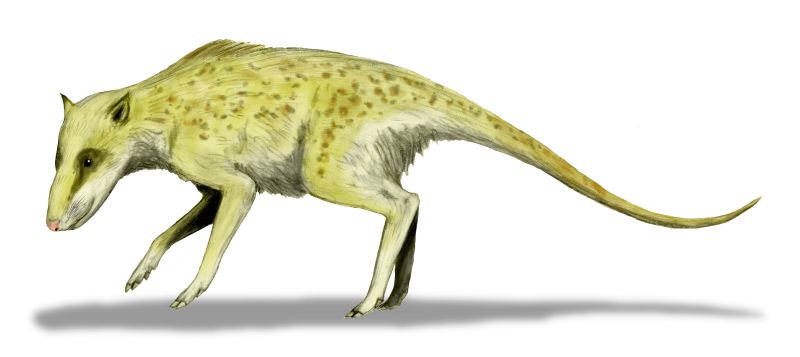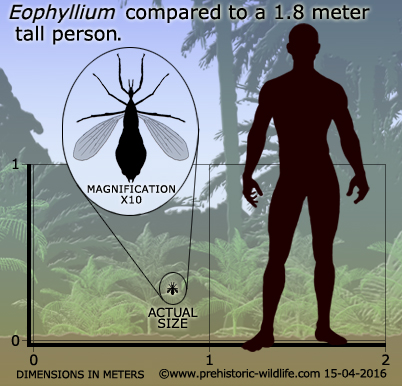|
|
Post by Talira Greycrest on Sept 1, 2021 10:28:42 GMT
Name: Ectopocynus
Pronunciation: Ek-toe-po-cy-nus
Meaning of name: "Strange dog"
Species: E. antiquus, E. intermedius, E. simplicidens
Size: Uncertain due to a lack of fossils.
Family: Canidae
Diet: Carnivore
First fossils found: Known only from teeth and mandibles discovered in the western and midwestern United States. All known species named in 1994.
Lived: Depending on species, lived between 33.3 and 15.97 million years ago from the Rupelian stage of the Early Oligocene through to the Burdigalian stage of the Early Miocene in what is now the western and midwestern United States.
Unfortunately, I was unable to find any pictures of this prehistoric canine.
|
|
Tix Mascot
Tech guru
Italy is my second homeland
Posts: 11,097  Mini-Profile Background: {"image":"http://4.bp.blogspot.com/-X5mhw13BJ7Y/TwKeZ3uM7YI/AAAAAAAABPw/D82go4Ny_8E/s1600/italy-background-8-787281.jpg","color":""}
Mini-Profile Text Color: 0ef8f1
Mini-Profile Name Color: f40d39
Year of Birth: 1961
Nationality: Norwegian
Mini-Profile Background: {"image":"http://4.bp.blogspot.com/-X5mhw13BJ7Y/TwKeZ3uM7YI/AAAAAAAABPw/D82go4Ny_8E/s1600/italy-background-8-787281.jpg","color":""}
Mini-Profile Text Color: 0ef8f1
Mini-Profile Name Color: f40d39
Year of Birth: 1961
Nationality: Norwegian
|
Post by Tix Mascot on Sept 1, 2021 11:56:38 GMT
Are those parts of its skull? Casts like this can be made by filling the brain cavity with liquid rubber. It allows scientists to estimate the sizes of various parts of the brain. Awesome! Didn't think about that, but it makes good sense. |
|
|
|
Post by Joey12 on Sept 2, 2021 5:47:27 GMT
I know about strange dogs as we have one.
|
|
|
|
Post by Talira Greycrest on Sept 2, 2021 10:19:44 GMT
Today's entry is a prehistoric elephant: Name: AmebelodonPronunciation: Am-e-bel-oh-donMeaning of name: "Shovel tooth"Species: A. fricki, A. floridanusSize: Depending on species, measured around 3 metres long, between 2.5 and 3 metres tall and weighing up to 10 metric tonnes.Family: AmebelodontidaeDiet: HerbivoreFirst fossils found: Known from several specimens discovered in Asia, Africa and the western, midwestern, south-central and southeastern United States. A. floridanus named by American palaeontologist, Joseph Mellick Leidy, in 1868. A. fricki named by American palaeontologist, Erwin Hinckley Barbour, in 1927. Lived: Depending on species, lived between 9 and 6 million years ago during the Tortonian and Messinian stages of the Late Miocene in what is now Asia, Africa and the western, midwestern, south-central and southeastern United States. Lower jawbone of A. fricki Lower jawbone of A. fricki |
|
Tix Mascot
Tech guru
Italy is my second homeland
Posts: 11,097  Mini-Profile Background: {"image":"http://4.bp.blogspot.com/-X5mhw13BJ7Y/TwKeZ3uM7YI/AAAAAAAABPw/D82go4Ny_8E/s1600/italy-background-8-787281.jpg","color":""}
Mini-Profile Text Color: 0ef8f1
Mini-Profile Name Color: f40d39
Year of Birth: 1961
Nationality: Norwegian
Mini-Profile Background: {"image":"http://4.bp.blogspot.com/-X5mhw13BJ7Y/TwKeZ3uM7YI/AAAAAAAABPw/D82go4Ny_8E/s1600/italy-background-8-787281.jpg","color":""}
Mini-Profile Text Color: 0ef8f1
Mini-Profile Name Color: f40d39
Year of Birth: 1961
Nationality: Norwegian
|
Post by Tix Mascot on Sept 2, 2021 15:47:37 GMT
Looks like a peace of an old machine...
|
|
|
|
Post by Joey12 on Sept 2, 2021 23:58:17 GMT
Looks like a wide mouth.
|
|
|
|
Post by Talira Greycrest on Sept 3, 2021 10:10:05 GMT
Name: IndohyusPronunciation: In-doe-hy-usMeaning of name: "India pig"Species: I. indirae, I. majorSize: 60cm longFamily: RaoellidaeDiet: OmnivoreFirst fossils found: Known from several specimens, including almost-complete skeletons, discovered in Pakistan and India. First discovered by Indian geologist A. Ranga Rao in 1971. Named by Mr. Rao in 1977.Lived: Depending on species, lived between 48.6 and 37.2 million years ago from the Ypresian stage of the Early Eocene through to the Priabonian stage of the Late Eocene in what is now India and Pakistan.
|
|
Tix Mascot
Tech guru
Italy is my second homeland
Posts: 11,097  Mini-Profile Background: {"image":"http://4.bp.blogspot.com/-X5mhw13BJ7Y/TwKeZ3uM7YI/AAAAAAAABPw/D82go4Ny_8E/s1600/italy-background-8-787281.jpg","color":""}
Mini-Profile Text Color: 0ef8f1
Mini-Profile Name Color: f40d39
Year of Birth: 1961
Nationality: Norwegian
Mini-Profile Background: {"image":"http://4.bp.blogspot.com/-X5mhw13BJ7Y/TwKeZ3uM7YI/AAAAAAAABPw/D82go4Ny_8E/s1600/italy-background-8-787281.jpg","color":""}
Mini-Profile Text Color: 0ef8f1
Mini-Profile Name Color: f40d39
Year of Birth: 1961
Nationality: Norwegian
|
Post by Tix Mascot on Sept 3, 2021 16:12:05 GMT
Not very different looking from modern species.
|
|
|
|
Post by Joey12 on Sept 4, 2021 2:38:03 GMT
I agree, looks like severall different dogs all in one.
|
|
|
|
Post by Talira Greycrest on Sept 4, 2021 9:45:34 GMT
Today's entry is a tiny insect: Name: EophylliumPronunciation: E-oh-fil-le-umMeaning of name: "Dawn Phyllium"Species: E. messelensisSize: 6cm longFamily: PhylliidaeDiet: HerbivoreFirst fossils found: Known only from a single, almost-complete specimen discovered in the Messel Formation of Germany. Named by S. Wedmann, S. Bradler and J. Rust in 2007.Lived: 47 million years ago during the Lutetian stage of the Early Eocene in what is now Germany. |
|
Tix Mascot
Tech guru
Italy is my second homeland
Posts: 11,097  Mini-Profile Background: {"image":"http://4.bp.blogspot.com/-X5mhw13BJ7Y/TwKeZ3uM7YI/AAAAAAAABPw/D82go4Ny_8E/s1600/italy-background-8-787281.jpg","color":""}
Mini-Profile Text Color: 0ef8f1
Mini-Profile Name Color: f40d39
Year of Birth: 1961
Nationality: Norwegian
Mini-Profile Background: {"image":"http://4.bp.blogspot.com/-X5mhw13BJ7Y/TwKeZ3uM7YI/AAAAAAAABPw/D82go4Ny_8E/s1600/italy-background-8-787281.jpg","color":""}
Mini-Profile Text Color: 0ef8f1
Mini-Profile Name Color: f40d39
Year of Birth: 1961
Nationality: Norwegian
|
Post by Tix Mascot on Sept 4, 2021 11:53:08 GMT
The wings look fragile.
|
|
|
|
Post by Talira Greycrest on Sept 5, 2021 10:28:24 GMT
Name: PresbyornisPronunciation: Press-by-or-nisMeaning of name: "Elderly bird"Species: P. pervetus, P. isoniSize: Depending on species, measured 1 metre long and 1.5 metres tall.Family: PresbyornithidaeDiet: Filter-feederFirst fossils found: Known from several specimens discovered in Canada and the Mid-Atlantic region and western United States. P. pervetus named by American ornithologist and palaeontologist, Frank Alexander Wetmore, in 1926. P. isoni named in 1994.Lived: Depending on species, lived between 58.7 and 48. 6 million years ago from the Thanetian stage of the Late Paleocene through to the Ypresian stage of the Early Eocene in what is now Canada and the Mid-Atlantic region and western United States.
 An assemblage of P. pervetus skeletons on display at the American Museum of Natural History. An assemblage of P. pervetus skeletons on display at the American Museum of Natural History.
|
|
|
|
Post by Joey12 on Sept 6, 2021 6:16:01 GMT
I guess I'm not sure what I'm looking at.
|
|
|
|
Post by Talira Greycrest on Sept 6, 2021 7:01:10 GMT
Today's entry is the largest-known tortoise: Name: MegalochelysPronunciation: Meg-ah-lo-chel-issMeaning of name: "Big shell"Species: M. atlas, M. margae, M. sondaariSize: The largest species, M. atlas, measured between 2.5 and 2.7 metres long and weighed between 1 and 2 metric tonnes.Family: TestudinidaeDiet: HerbivoreFirst fossils found: Known from several specimens discovered in Pakistan, India, Thailand, the Philippines and Indonesia. M. atlas named by Scottish palaeontologist, Hugh Falconer, and English palaeontologist, Sir Proby Thomas Cautley, in 1837. M. sondaari named in 2007. Uncertain of when M. margae was named.Lived: Depending on species, lived between 7.246 and 1.7 million years ago from the Messinian stage of the Late Miocene through to the Calabrian stage of the Middle Pleistocene in what is now Pakistan, India, Thailand, the Philippines and Indonesia.  M. atlas skeleton on display at the American Museum of Natural History M. atlas skeleton on display at the American Museum of Natural History |
|
Tix Mascot
Tech guru
Italy is my second homeland
Posts: 11,097  Mini-Profile Background: {"image":"http://4.bp.blogspot.com/-X5mhw13BJ7Y/TwKeZ3uM7YI/AAAAAAAABPw/D82go4Ny_8E/s1600/italy-background-8-787281.jpg","color":""}
Mini-Profile Text Color: 0ef8f1
Mini-Profile Name Color: f40d39
Year of Birth: 1961
Nationality: Norwegian
Mini-Profile Background: {"image":"http://4.bp.blogspot.com/-X5mhw13BJ7Y/TwKeZ3uM7YI/AAAAAAAABPw/D82go4Ny_8E/s1600/italy-background-8-787281.jpg","color":""}
Mini-Profile Text Color: 0ef8f1
Mini-Profile Name Color: f40d39
Year of Birth: 1961
Nationality: Norwegian
|
Post by Tix Mascot on Sept 6, 2021 11:14:53 GMT
That's an awful lot of tortoise soup!  |
|